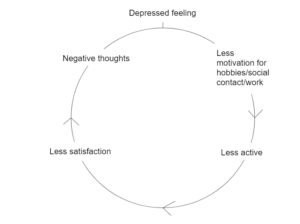With a sociogram, we can clearly display which people you are close to.
How does it work?
Write your own name in the middle of the circle and write the names of other people you feel are close to you in the circles around your name. The closer someone feels to you, the closer you put them to the inner circle. This includes people with whom you are ‘close’, but also people with whom you only have occasional contact.

How does it feel to see your sociogram like this?
________________________________________________________
Are there things you would like to see differently?
________________________________________________________
An example of a sociogram:

In this example, they feel closest to their mother and partner, which is why they are in the first circle, which is closest to the ‘me’ in the middle. In the next circle is cousin A, the best friend and the father, therefore they do not feel as close to these people as their mother and partner, but close nonetheless. The people in the following circle are a little more distant, and the outermost circle, with the neighbour and a fitness buddy, are the furthest away.
During interpersonal psychotherapy (IPT), you will discuss many of the important relationships and life events that you have experienced. Relationships and mood influence each other greatly. With the help of your practitioner, you will identify which important events occurred prior to your current depression.
You will do this by creating a lifeline. Creating a lifeline allows you to map and link events chronologically. This will help make it clear at a glance which events occurred and when.
All your life events can be found on your lifeline, from social relationships to life events. This will allow you to see whether there is an association between certain events and the onset of your depression. For some of the events, your practitioner will ask what happened, how you felt whilst they occurred and how you dealt with them.
How do you create a lifeline?
On a large sheet of paper, draw a horizontal line (see the example below). The left side of the line represents the moment you were born, and the right side of the line represents your current age. On this line, you will pinpoint all the moments in your life that were important to or emotionally charged for you.

Sources: Leerboek Interpersoonlijke psychotherapie, Marc Blom, Bohn Stafleu van Loghum, 2011.
It is important to gain insight into your daily activities, how enjoyable they are and how they affect your mood.
You can write down your activities.
This form will help you to register which activities you have done, when you did them, how much you enjoyed the activity, how competent you felt and what mood you were in during the activities.
How do I fill in the Activity Form?
Record every activity you do every day for at least a week (e.g. breakfast, walking, drinking coffee, shopping, showering, etc.).
Then fill out the following things:
- How enjoyable the activity was on a scale of 0-10 (0 = not at all pleasant / ‘must’, 10 = very pleasant)
- How competent you felt on a scale of 0-10 (0 = not competent at all, 10 = extremely competent).
- What mood you were in on a scale of 0-10 (0 = very depressed, 10 = not depressed at all)
During your next session, you will discuss the completed list with your practitioner and see how your activities and mood may influence each other.
Activity form
Date: ________________
| Time of day | Activity | Enjoyment
(0-10) * |
Competence (0-10) ** | Mood (0-10) *** |
* Enjoyment: Take notes on how enjoyable the activity was. P-score 0-10 (0 = not at all pleasant / must, 10 = very pleasant)
** Competence: Write down how well you were able to carry out the activity. B-score 0-10 (0 = not competent at all, 10 = extremely competent).
*** Mood: 0-10 (0 = very depressed, 10 = not depressed at all)
An example of a completed activity form
Date: Monday, August 5
| Time of Day | Activity | Enjoyment
(0-10) * |
Competence (0-10) ** | Mood (0-10) *** |
| Morning | Get up | 1 | 3 | 2 |
| Morning | Breakfast | 2 | 5 | 3 |
| Morning | Yoga lesson | 7 | 7 | 7 |
| Afternoon | Grocery shopping | 0 | 3 | 2 |
| Afternoon | Coffee | 5 | 7 | 6 |
| Afternoon | Cleaning the house | 0 | 3 | 3 |
| Evening | I had dinner but wasn’t hungry. | 1 | 3 | 3 |
| Evening | Watching TV. | 6 | 6 | 6 |
* Enjoyment: Take notes on how enjoyable the activity was. P-score 0-10 (0 = not at all pleasant / must, 10 = very pleasant)
** Competence: Write down how well you were able to carry out the activity. B-score 0-10 (0 = not competent at all, 10 = extremely competent).
*** Mood: 0-10 (0 = very depressed, 10 = not depressed at all)
References: Keijsers, G. P. J., Van Minnen, A., Verbraak, M., Hoogduin, C. A. L. & Emmelkamp, P., (2017). Protocollaire behandelingen voor volwassenen met psychische klachten
Depression is a condition that is considered a ‘mood disorder’. Its main characteristics are a long-lasting low mood, lethargy and/or a loss of interest or an inability to enjoy anything. One in seven Dutch people experience depression during their lifetime. Depression is twice as common in women as in men.
What are the symptoms?
The Diagnostic Manual for Psychologists (DSM-5) indicates that the following symptoms are associated with depression:
- Depressed mood during most of the day, almost every day;
- Reduction of interest or pleasure in (almost) all activities, almost all day, almost every day;
- Inadvertent, obvious weight loss or weight gain, or a decreased or increased appetite almost every day;
- Sleep complaints: not being able to sleep (sufficiently), sleeping too much, almost every day;
- Psychomotor agitation, restlessness or inhibition almost every day;
- Fatigue or loss of energy almost every day;
- Feelings of worthlessness, or excessive and wrongful guilt;
- Diminished ability to think or concentrate, or indecisiveness;
- Recurring thoughts of death, suicidal thoughts, fantasies about suicide with or without plans, or attempted suicide;
To be diagnosed with depression, 5 or more of the above symptoms must be present for a period of at least two consecutive weeks.
How does depression develop?
There are a lot of factors that influence the onset of depression, such as biological or genetic factors, environmental factors and life events. These are often major life events such as job loss, death of a loved one or conflicts. It can also be due to problems that have been going on for a long time but are starting to become a burden. It is also possible that we are burdened for too long with too many problems at once or confronted with too many problems too quickly. Sometimes even pleasant but far-reaching changes can also give rise to a lot of stress: think of a move, promotion at work or a change of job, for example.
The vicious circle of behaviour
A low mood and fatigue are often accompanied by the emergence of negative or sombre thoughts. These can make you feel less motivated and, in turn, you will do less during the day. When you do less, you can feel guilty or less satisfied about your day. This in turn reinforces the feeling of gloom, further decreasing your motivation. This vicious circle causes someone to withdraw further and further.
Want to read more about the vicious circle? Click here.
Therapy
One of the most effective forms of treatment is Cognitive Behavioural Therapy (CBT). CBT focuses on your thoughts and behaviour. With the help of your therapist, you will try to break the vicious behavioural circle with the help of behavioural activation and by applying structure to your days. In small steps, we will try to increase the amount of daily activities you do that give you energy and make you feel positive. This process addresses symptoms such as avoidance, withdrawal and inactivity. The goal is to get you to be more active again, resulting in experiencing more satisfaction. This activation can also reduce fatigue and improve sleep, making you feel better step by step. It is important to keep a consistent schedule, eat regularly, exercise more and keep in touch with friends and family.
The second part of the treatment consists of cognitive therapy. Cognitive therapy is a systematic method that helps you to understand the thoughts that lead to unpleasant feelings. You learn to think differently, and, in turn, your negative feelings will decrease. Three steps are taken:
- You learn how to become aware of negative automatic thoughts;
- You learn to become aware of the underlying beliefs that reinforce these thoughts;
- You learn to challenge and investigate the negative automatic thoughts and opinions by asking critical questions about them. You will then consider whether alternative perspectives or thoughts are possible. You do this with the help of a thought record.
Source: PsyQ: what is CBT
Keijsers, G. P. J., Van Minnen, A., Verbraak, M., Hoogduin, C. A. L. & Emmelkamp, P., (2011). Protocol-based treatments for adults with psychological complaints.
DSM-5: Dutch translation, American Psychiatric Association, Boom Publishers (2014)
Cognitive Therapy (CT) focuses on the connection between our thoughts and feelings. The way we interpret our experiences can play a major role in our negative feelings. Based on your experiences, you form ideas and beliefs about yourself, others and the world. These ideas are called ‘cognitive schemas’ or core beliefs. Based on these core beliefs, you can regulate and evaluate your behaviour, which makes life more manageable. In the past, these core beliefs might have been useful to you when coping with a period in your life, but they can cause problems later on in life. For example, these core beliefs can start to evoke negative thoughts, which limit your performance. A limiting core belief could be: “I have to do everything I do well, otherwise I am worth nothing”. Since a person simply cannot do everything well, there is a good chance that such a core belief will cause negative feelings eventually.
The emergence of the thought circle
Negative thoughts impose themselves automatically, without someone being consciously aware of their core beliefs or schemas. The occurrence of negative thoughts increases more and more and is often accompanied by an increase in depressed mood and other negative feelings. As the sadness grows, negative thoughts become more common, more intense and increasingly credible. Thinking negatively becomes a habit. That is why it becomes increasingly difficult to put these thoughts into perspective. All this, again, reinforces the negativity.
It is a vicious circle in which you can get trapped in: the sadder you feel, the more negative thoughts arise. These thoughts become more and more credible, which in turn reinforces the sadness. This vicious circle is shown below.

So, negative thinking can gradually become a habit. This is often the case with habits of which you don’t actually realize that you have them. This can make it seem as if a certain event leads directly to a negative mood, while there is actually a mediator: your thoughts. These thoughts are also called ‘negative automatic thoughts’ because of their negative consequences.
Vicious circle
When you combine the vicious negative behavioural circle and the thought circle, it results in the circle below. It shows that behaviour and thoughts are connected and influence each other.

Breaking the circle with cognitive therapy
The aim is to learn to break the circle. This can be done using cognitive therapy (CT). You will learn to investigate which thoughts are influencing or worsening your depressed moods, based on a situation that you experienced prior to your depression. You will take note of these thoughts and decide if they are realistic and correct. You will then begin to challenge these thoughts and try to look at the event from a different perspective. This can, in turn, affect your mood. Lastly, attention is paid to the core beliefs that underlie the automatic negative thoughts. These core beliefs and schemas are examined and adjusted as needed.
Source: Keijsers, G. P. J., Van Minnen, A., Verbraak, M., Hoogduin, C. A. L. & Emmelkamp, P., (2017). Protocol-based treatments for adults with psychological complaints.
Almost everyone experiences stress at work from time to time. However, when this stress persists for a long period of time, stress-related complaints can arise. Below, you will find a number of tips to deal with the stress in order to prevent long term complaints.
1. Make sure you find a good balance between work and relaxation
Make sure that after a stressful period, you give yourself a moment for relaxation. When you are relaxing, try not to busy yourself with work-related tasks. By giving yourself a break after the stress, you are less likely to exceed your limits and exhaust yourself. You could try a relaxation exercise .
2. Have the courage to say ‘no’
Learning how to say ‘no’ can save you a lot of time and energy. Start by saying ‘no’ to something small, or by practicing with a person who you might find it easier with. Then you can start applying this at your workplace. In order not to say ‘yes’ too quickly, you can ask for some time to consider when a colleague asks you to do something. Then you can consider whether or not you have time to carry out the task. In this article , you will find some tips on being assertive.
3. Set achievable goals
By setting achievable goals, you can ensure that you do not ask too much of yourself. For example, divide the task you have to complete into several sub-tasks. With every sub-task you complete, you will feel fulfilled and increase your motivation to continue working on the task.
4. Set priorities
If you take on too many tasks at the same time, the chances are small that you will be able to perform them all efficiently and properly. Which task is the most important at the moment? It is useful to make a list about what is a priority that day, so that you have a clear overview. It is important that the number of daily tasks is realistic and achievable.
5. Make sure you have time for fun things besides work
Meet up with a friend or go walking / running / rollerblading through the woods. By engaging in activities other than work, you can shake off your worries and recharge for the following workday.
Assertive behavior is focussed on standing up for yourself, with respect for one’s own goals and the goals of the other. There are three stages of assertive behavior:
Sub-assertive ——— Assertive ——— Aggressive
Sub-assertive behavior means that you take too much account of others and too little with yourself. Aggressive behavior means that you only take yourself into account and too little of others. Assertiveness lies in the middle of these two extremes.You focus on standing up for yourself, with respect for the other.
How can you become more assertive?
1. Saying ‘No’ is already sufficient
Saying no is a difficult thing to do for many people. We tend to explain our rejection, for example: “You can not borrow that book, because …” But in most cases you do not even have to give an explanation! When people ask why you refused, you can just answer with: “I prefer not to.”
2. Attack the confrontation
If you find it difficult to be assertive, you can change this by practicing, because practice makes perfect. The first step to become more assertive, is usually the most difficult step. This is because you have to do something that you would rather not do. When you face the confrontation you will learn to be more assertive. Try starting with saying no to something small, or to someone you know very well and trust.
3. Relax
Being assertive can be scary, you may experience some tension. You should try to relax when you feel this way, you will experience that the fear will decrease. You can do this by, for example, tightening your muscles first and then relaxing them again or taking a few deep breaths.
4. Use “I” messages
If you want to indicate that you do not like the behavior of the other person, you can best start the sentence with an ‘I’. For example: “I can not concentrate if you make so much noise.” Avoid sentences with words that start with ‘you’, such as: ‘You are always so noisy’. In this way, people are more likely to feel attacked.
5.Be assertive
The message that you transfer to the other person is important, but your attitude and the way you use your voice are also key factors of assertive behavior. Your attitude should be accessible and approachable. You achieve such attitude by relaxing; also try to relax your arms and legs as much as possible. When it comes to your voice, try to speak loud and clear. Also try to apply variation in the sound of your voice.
6. Prepare yourself
In many cases you can prepare assertive behavior. Think, for example, of situations in which you have difficulty asserting yourself. For example when your colleague asks you to do things at work where you do not have the time for. In this case you can practice at home for an appropriate response. Then you will know that you have it in you to react appropriately, so that you can be more confident about yourself.
7. Observe
Are there people around you who are assertive? Observe them. Look at the way they move and which words they use. In this way you know how to act in an assertive way and you will know that it is possible to be assertive. It is also important to observe the reaction of the person who receives the assertive message. How does that person respond to this?
8. Do not be too assertive
Some people who want to be more assertive are taking it too far in the beginning. Behavior is only assertive if you have an eye for your own interests as well as the interests of the other person. Try to give your opinion in a calm but clear way. It should be clear that you respect the other person.

